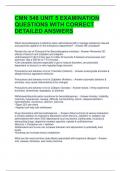CMN 548 UNIT 5 EXAMINATION
QUESTIONS WITH CORRECT
DETAILED ANSWERS
Which benzodiazepine is effective when administered IM to manage substance induced
and psychotic agitation in the emergency department? - Answer-IM Lorazepam
Review the use of Flumazenil for Benzodiazepine overdose - Answer-•Reverses OD
effects of benzo's and zolpidem and zaleplon
•Administered IV @ 0.2 then give 0.3 after 30 seconds if desired consciousness isn't
achieved. Has a half life of 7-15 minutes.
•Can precipitate seizures especially in ppl w/ seizure disorders, are physically
dependent on benzo's or who ingested large amounts
Precautions and adverse rxns for Triazolam (Halcion): - Answer-anterograde amnesia &
alleged serious aggressive behavior
Precautions and adverse rxns for Zolpidem (Ambien): - Answer-automatic behavior &
amnesia, may cause hallucinations & bx changes
Precautions and adverse rxns for Zalepon (Sonata): - Answer-doses >10mg experience
dizziness, drowsiness, dyspepsia, or diarrhea
Withdrawal/discontinuation syndrome for benzodiazepines. - Answer-Anxiety, irritability,
insomnia, hyperacusis, nausea, difficulty concentrating, tremor, depersonalization,
hyperesthesia, myoclonus, delirium, seizures.
•Taper 25% per week
•Tegretol can help with withdrawal
Drug interactions with benzodiazepines : - Answer-•Most common & serious interaction
is excess sedation & respiratory depression when benzo's, zolpidem or zaleplon are
administered with other CNS depressants such as alcohol, barbiturates, tricyclics &
tetracycling drugs, dopamine receptor agonists, opioids & antihistamines
•Benzo's + Clozapine can = delirium
•Nefazodone and Luvox can increase triazolam and alprazolam to potentially toxic
levels
•Smoking can increase benzo metabolism
What are the most common side effects associated with buspirone (Buspar) - Answer-
•HA, nausea, dizziness, and rarely insomnia
,•NO wt gain, sexual dysfunction, discontinuation syndrome, sleep disturbances,
sedation or cognitive/psychomotor impairment
Review drug interactions for buspirone (Buspar) - Answer-•Used w/ Haldol it increases
Haldol levels
•Don't use with MAOI; wash out for 2 weeks
•Drugs/foods that inhibit CYP3A4 such as grapefruit juice, E-mycin, itraconazole,
serzone...
What two options do clinicians have when switching from a benzodiazepine to
buspirone? - Answer-Start buspar treatment gradually while the benzo is being
withdrawn
Start buspar treatment and bring the patient up to a therapeutic dose for 2-3 weeks
while the person is still receiving the regular dose of benzo's and then slowly taper the
benzo
Dopamine Receptor Antagonists (DRAs), also known as First Generation Antipsychotics
(FGAs) and Neuroleptics include all of the antipsychotics in which chemical classes? -
Answer--phenothiazines, butryophenones, thioxanthenes, dibenzoxazepines,
dihydroindoles, & diphenylbutylpiperidines-
Although Typical Antipsychotics are associated with EPS syndromes, their use is still
considered as they differ from newer Atypical agents in that they do not have what risk
associated with them? - Answer--Low risk of metabolic abnormalities
Discuss the general peak plasma concentrations for both oral and parenteral
administration of DRAs. How long will it take to reach steady-state levels? What are the
differences in bioavailability between oral and parental administration? - Answer--
Reaches peak plasma concentrations in 1-4 hours after oral administration & 30-60
minutes after parenteral administration
-Steady state levels are reached in approximately 3-5 days
-Bioavailability is up to tenfold higher with parenteral administration
Why would oral administration of DRAs need to continue if a patient is placed on a
depot parenteral formulation? How long should oral therapy be continued? - Answer--
Depot parenteral can take up to 6 months to reach steady state plasma levels and
therefore PO medication should be continued during the 1st month or so
Discuss the meaning of potency when referring to a DRA, including the risks associated
with high potency agents. - Answer--Potency: the amount of drug that is required to
achieve therapeutic effects
-Low potency: creates more sedation and weight gain than higher potency drugs
-High potency: creates more risk for EPS sxs
the factors that can influence the pharmacokinetics of Antipsychotics: - Answer-Age,
medical condition, enzyme inducers, clearance inhibitors, changes in binding protein
, What are the therapeutic indications for DRAs/Typical
Antipsychotics/Neuroleptics/FGAs? - Answer-●Schizophrenia and Schizoaffective
Disorder
●Mania
●Depression with Psychotic Symptoms
●Delusional Disorder
●Severe Agitation and Violent Behavior
●Tourette's Disorder
●Borderline Personality Disorder
●Dementia and Delirium
●Substance-induced Psychotic Disorder
●Childhood Schizophrenia
Discuss the impact of FGAs on positive and negative symptoms of schizophrenia -
Answer--FGAs produce their most dramatic effects against the positive sxs
-Negative sxs are less likely to improve significantly and they may appear to worsen
For patients experiencing their first episode of psychosis, how long should these
patients be maintained on FGAs? For patients with multiple episodes of psychosis, how
long should these patients be maintained on FGAs? - Answer--1st episode psychosis:
1-2 years
-multiple episodes of psychosis: 2-5 years
Why would the clinician use a DRA along with lithium or other antimanic agent in
treating psychotic symptoms of acute mania? - Answer--Antimanic's have slower onset,
so it is standard practice to start an DRA/SGA to treat acute sxs of mania and then
slowly withdraw the DRA.
Which two FGAs are most frequently used to treat Tourette's Disorder? - Answer--
Haldol & pimozide (orap)
In treating an elderly patient with a DRA for agitation associated with delirium, what are
the most problematic side effects in this elderly population? - Answer--orthostatic
hypotension, parkinsonism, & worsened cognition.
Neuroleptic Malignant Syndrome: Know symptoms and time frame for evolution, lab
values, incidences in men vs women, young vs old, treatment (dantrolene and
bromocriptine). - Answer-oNMS can occur at any time during the course of DRA tx
osxs: hyperthermia, muscle rigidity, dystonia, akinesia, mutism, confusion, agitation &
increased P/BP.
-sxs evolve over 24-72 hours
olab findings: increased WBC, creatinine phosphokinase, liver enzymes, plasma
myoglobin & myoglobinuria & occasionally renal failure
omen affected more frequent than woman, younger affected more than elder




